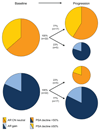Plasma AR and abiraterone-resistant prostate cancer
- PMID: 26537258
- PMCID: PMC6112410
- DOI: 10.1126/scitranslmed.aac9511
Plasma AR and abiraterone-resistant prostate cancer
Abstract
Androgen receptor (AR) gene aberrations are rare in prostate cancer before primary hormone treatment but emerge with castration resistance. To determine AR gene status using a minimally invasive assay that could have broad clinical utility, we developed a targeted next-generation sequencing approach amenable to plasma DNA, covering all AR coding bases and genomic regions that are highly informative in prostate cancer. We sequenced 274 plasma samples from 97 castration-resistant prostate cancer patients treated with abiraterone at two institutions. We controlled for normal DNA in patients' circulation and detected a sufficiently high tumor DNA fraction to quantify AR copy number state in 217 samples (80 patients). Detection of AR copy number gain and point mutations in plasma were inversely correlated, supported further by the enrichment of nonsynonymous versus synonymous mutations in AR copy number normal as opposed to AR gain samples. Whereas AR copy number was unchanged from before treatment to progression and no mutant AR alleles showed signal for acquired gain, we observed emergence of T878A or L702H AR amino acid changes in 13% of tumors at progression on abiraterone. Patients with AR gain or T878A or L702H before abiraterone (45%) were 4.9 and 7.8 times less likely to have a ≥50 or ≥90% decline in prostate-specific antigen (PSA), respectively, and had a significantly worse overall [hazard ratio (HR), 7.33; 95% confidence interval (CI), 3.51 to 15.34; P = 1.3 × 10(-9)) and progression-free (HR, 3.73; 95% CI, 2.17 to 6.41; P = 5.6 × 10(-7)) survival. Evaluation of plasma AR by next-generation sequencing could identify cancers with primary resistance to abiraterone.
Copyright © 2015, American Association for the Advancement of Science.
Conflict of interest statement
The Institute of Cancer Research developed abiraterone and therefore has a commercial interest in this agent. G.A. is on the ICR list of rewards to inventors for abiraterone. J.S.d.B. has received consulting fees and travel support from Amgen, Astellas, AstraZeneca, Boehringer Ingelheim, Bristol-Myers Squibb, Dendreon, Enzon, Exelixis, Genentech, GlaxoSmithKline, Medivation, Merck, Novartis, Pfizer, Roche, Sanofi-Aventis, Supergen and Takeda, and grant support from AstraZeneca and Genentech. G.A. has received honoraria, consulting fees or travel support from Astellas, Medivation, Janssen, Millennium Pharmaceuticals, Ipsen, Ventana and Sanofi-Aventis, and grant support from Janssen, AstraZeneca and Arno. The other authors do not declare any competing interests.
Figures




Comment in
-
Liquid biopsy: Clues on prostate cancer drug resistance.Sci Transl Med. 2015 Nov 4;7(312):312fs45. doi: 10.1126/scitranslmed.aad4008. Sci Transl Med. 2015. PMID: 26537254
-
Application of liquid biopsies to identify genomic factors associated with therapy resistance in castration resistant prostate cancer.Ann Transl Med. 2016 Oct;4(Suppl 1):S64. doi: 10.21037/atm.2016.10.39. Ann Transl Med. 2016. PMID: 27868032 Free PMC article. No abstract available.
References
-
- Scher HI, et al. Increased survival with enzalutamide in prostate cancer after chemotherapy. N Engl J Med. 2012 Sep 27;367:1187–1197. - PubMed
Publication types
MeSH terms
Substances
Grants and funding
LinkOut - more resources
Full Text Sources
Other Literature Sources
Medical
Molecular Biology Databases
Research Materials
Miscellaneous

